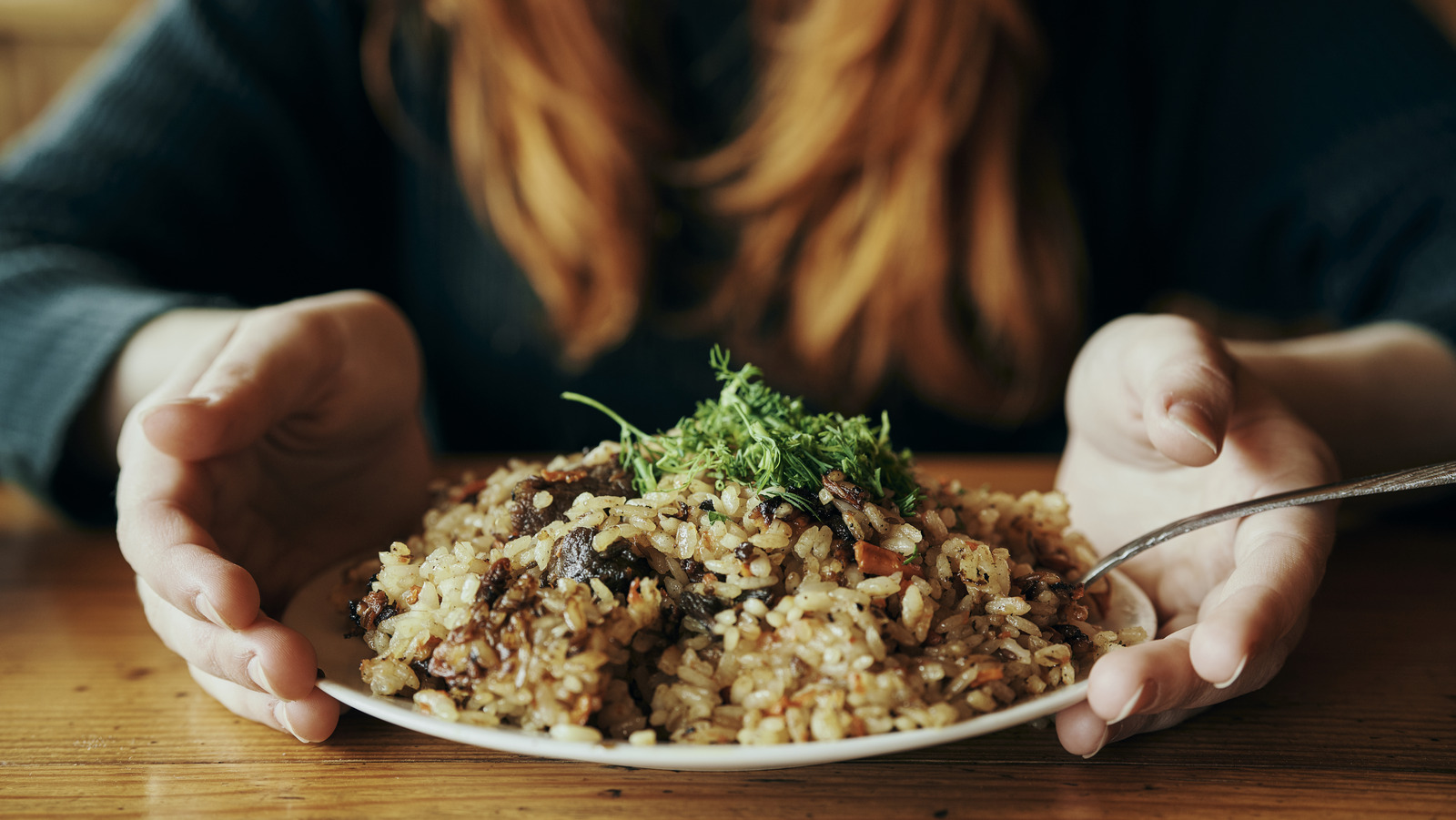
We're all for plain rice, but sometimes, it can come off a little bland. Sure, it's great for sampling alongside tasty options like herbed salmon and , but adding more flavor to your rice can also enhance an overall dish. So, how is it done? Easy.
Since rice-making is straightforward, adding exciting ingredients isn't hard. Whether you keep it simple or go all out with unique seasonings, enhancing ordinary grains with bold ingredients brings a delicious depth to dishes that take them from drab to fab. In this post, we're introducing some of the best ways to incorporate traditional and non-traditional flavors into bland rice.
From ordinary ingredients to hearty additions, we're giving you the details you need to make plain rice taste better. We'll even get you the steps on how to add each ingredient to rice to ensure optimal results. Stay tuned; we've got some easy ways to season bland rice coming your way.
Cook rice in broth Using broth is an easy way to infuse flavor into rice. There are several types of broth available, any of which you could use to enhance the taste of rice. Common options include vegetable broth, chicken broth, or beef broth.
Stock is also an option, but unlike broth made from meat, it is made with bones. There are other subtle differences as well, although both function similarly when it comes to seasoning rice. When using broth or stock to season rice, simply replace the water you'd typically use to cook the rice with either liquid.
Please note that though broth and stock are tasty on their own, their flavors might not be as pronounced when added to rice. To fix this, you can add butter, salt, pepper, garlic, or other ingredients. More ways to amp up the flavor of rice include using bouillon cubes diluted with water or , which is a paste-like substance full of condensed flavor, also to be diluted in water.
Use any of these ingredients the same way you would broth to enhance rice flavoring. Want to take things up a notch? Consider adding wine to the broth as seen in this . If you're really adventurous, you may even wish to skip the broth completely and allow the wine to take its place.
Yes, it's a lot of wine, no, it isn't conventional, but Add mushrooms Mushrooms are another way to enhance bland rice as the umami flavor melds well with many of the other ingredients mentioned on this list. Plump and beefy, mushrooms not only elevate rice in terms of flavor but can add complexity to its texture, as well. To , simply cook your mushrooms ahead of time before throwing in all your ingredients.
Boil covered until rice is tender. Alternatively, you can cook the mushrooms separately and stir them in once your rice has cooked on its own. The types of mushrooms you choose to layer into your rice is up to you, with options like shiitake, button, Portabello, and oyster available.
Stems too thick on whole mushrooms? Try removing them and cooking them first (a few minutes will do) before slicing the tops and adding them to your skillet later. Either way, mushrooms are a quick and easy way to season bland rice and taste especially decadent when combined with wine, broth, and other decadent ingredients. Flavor rice with garlic cloves Using garlic cloves to season rice is a great idea, but doing so isn't as simple as boiling the cloves in rice water.
Instead, it's better to sear your garlic in a skillet with oil or butter before adding cooked rice to the mix if you want to enjoy garlic clove's full range of flavor. When adding cooked rice, it's generally best to ensure that the rice is chilled before frying it in oil and garlic. In fact, most call for cooled rice since frying it hot and fresh can turn it into mush.
Trust us, here — we know from experience. When using garlic cloves, be sure to peel them first, leaving no skins attached. Do some research beforehand since there are plenty of that could save time and effort.
As far as how to prepare your garlic cloves, consider chopping them finely with a knife, using a tool like this , grating each clove over a grater (watch your fingers!), crushing each clove with your hand, or leaving them whole. Melt butter into rice A pat of butter can make all the difference when added to rice, and there are multiple ways to impart its rich flavor. The first is to simply add your butter over steamy rice with a bit of salt, thereby achieving awesome flavor without all the extra steps.
Another way to use butter to season bland rice includes toasting the rice in the decadent ingredient before cooking. Yep, you read that right. decreases the amount of starch in each grain, making for a lighter and fluffier texture once cooked.
Moreover, toasting your rice beforehand embeds it with nutty flavors that improve the taste. In fact, and other dishes. But the fun doesn't stop there.
Consider sautéing other rice add-ins, like the previously mentioned mushrooms and garlic, in butter to provide an additional layer of flavor and richness. Enhance it with tomato-based sauces or salsa If you know anything about making Spanish rice from scratch, you know how valuable tomato-based sauces can be for jazzing up bland rice. Though a combination of chicken broth and tomato sauce (or diced tomatoes) are generally used in Spanish rice recipes, other tomato-based options, like salsa, can be used, as seen in this Other types of tomatoey ingredients can also be added, including tomato paste, to add a fresh and bright zing of flavor sure to please your palate.
Another way to encourage tomato-like flavors in your rice is to (yes, it exists) You'll need the same amount of water you normally would use (usually 2 cups of water per every 1 cup of uncooked rice) along with 1 teaspoon of tomato bouillon. Beware of tomato bouillon's strong flavor here; you only need a teaspoon for every cup of tomato sauce. Not sure where to find tomato bouillon? While your local grocer may carry it, you may also have luck finding some brand online, like this found on Amazon.
Mix in veggies Vegetables add texture and color to your rice but also impart profound flavor. You have various options for incorporating vegetables into your rice, but for the sake of simplicity, we'll tell you about the easiest two. The first way to incorporate vegetables in your rice is to add them directly into the uncooked grains.
When doing it this way, it often helps to fry, cook, or boil the vegetables first to ensure they take on a softened texture. Add the veggies to the dry rice, along with your choice of liquid, and simmer with the top on until your rice is complete. The other method for adding vegetables to rice is to cook the rice and vegetables separately before stirring each component together, as seen in this .
Here, the flavor of the veggies may be slightly bolder since they haven't been submerged and boiled in liquid alongside the rice. Feel free to get creative with your vegetable combinations and choices regardless of the method you choose. Celery, onion, and green bell peppers are a winning combination, as are onions, peas, and carrots in fried rice.
Play around with it and see which mixes you like best. Give rice zest with cilantro and lime If you think cilantro and lime rice is only for fast food burrito chains, you're wrong. You can actually make deliciously zesty rice right from the comfort of your own home.
Flecked with cilantro and bursting with bright lime tartness, cilantro lime rice is surprisingly easy to make. According to this , you'll start by cooking the rice according to the package directions (along with a bit of salt, pepper, and garlic, of course). Meanwhile, prepare your cilantro and limes by washing them and slicing the limes into wedges.
Finely mince your cilantro so that it's speckled throughout the dish. Once your rice has finished cooking, squeeze the fresh lime juice into the rice and mix in your chopped cilantro leaves. Add a little extra salt if desired, or enjoy as is.
This is the perfect side dish to pair with a or . Delish! Get it gooey with cheese Adding cheese to your rice can lead to gooey satisfaction. To do it, simply add cheese to cooked rice while the rice is still hot, mixing it in as you go.
Then, top the rice with even more cheese, replace the lid (again only while the rice is still hot), and the cheese will form into one huge melty layer. When mixing cheese with rice, adding milk and a bit of chicken broth to your liquid can be beneficial, as these ingredients will up the flavor of your final cheesy rice creation. Feel free to mix in cooked broccoli, grilled onions, cooked carrots, and mushrooms — the world is your oyster.
Considering its flavor and creaminess, cheese is an amazing addition that can season bland rice effortlessly. Don't forget to experiment with different types of cheese flavors to see which you like best. We personally go ga-ga for Parmesan and cheddar, but other cheese varieties work just as well.
Upgrade rice with soy sauce This probably comes as no surprise, but using soy sauce to season bland rice is a great option for providing great flavor. Soy sauce adds saltiness and umami depth. To use it to make fried rice, you'll typically follow all the instructions in your fried rice recipe before adding a few dashes of soy to the mix.
Be careful not to add too much; not only will it make your rice unbearably salty, but it might prove too potent of a flavor as well. Instead, we recommend adding only one teaspoon at a time, tasting as you go, until you achieve the desired savor. Also, because of the saltiness that soy sauce brings, you'll want to go easy on table salt when it comes to seasoning your rice.
Pay attention to the type of soy sauce you use as well, as some varieties are reduced sodium, while other traditional versions will have its salt content blasting full throttle. Beans are a classic rice addition Though beans aren't technically a "seasoning," their savory flavor lends to a beautiful contrast, both in texture and in taste. There are various types of beans you can combine with rice, including black beans, pinto beans, red kidney beans, and more.
Just about any bean you enjoy will do, but cooking methods and times may differ depending on the variety. When combining rice with beans, there are a couple of ways to go about it. The first is to boil your rice separately before adding cooked beans (canned or beans cooked from scratch) along with your choice of seasonings.
The other method, which might prove far easier, is to simply use an Instant Pot to cook the rice and beans together. Believe it or not, , and following the instructions in this recipe is a sure way to achieve flavorful rice and beans. Even so, be advised that this method is not a shortcut.
The total cooking time will still take over an hour and a half, but, hey, fewer pots to have to deal with is a win. Use pantry spices and herbs We've mentioned several ingredients that can help season bland rice, but pantry spices are some of the most practical. Granulated garlic, smoked paprika, cumin, onion powder, and cayenne are all just a few of the seasonings you can add to your rice to take its flavor from good to incredible.
Which combinations you'll use will strongly depend on your recipe, as not all spices jive well with certain ingredients. When making , for example, expect to use a combination of cumin, garlic, cayenne, and paprika. Trying your hand at ? If so, use a combo of chili powder, garlic powder, onion powder, oregano, and a few other spices to make the rice come alive.
Curry powder is another great addition, while ginger and nutmeg lend interesting and unexpected flavor to bland rice dishes. Speaking of oregano, dried herbs are another awesome way to infuse flavor into your rice without needing to go overboard. While fresh herbs are always a worthy addition, dry herbs are more potent and have a longer life span.
Which you choose is up to you, just be sure not to replace them at a 1-to-1 ratio; a teaspoon of dried herbs is all you need to replace 1 tablespoon of fresh herbs. Mix in meat We're all for delightfully fluffy plain white rice, but sometimes it's fun to spice things up a bit by adding meat. There are so many ways to season bland rice with meat, and almost any type can be used to create a decadent side dish or entrée.
is often seasoned with sausage, chicken gizzards, or liver, while fried rice usually contains either chicken, pork, or shrimp. So, how do you add meat to rice? Our favorite method is to cook the meat before toasting the rice in the same pan. The rice will absorb the essence of the meat, which helps with flavor.
From there, you can add your choice of liquid and boil the rice until the grains are fully cooked. Whether you leave your meat to cook with the rice depends on your recipe; some may call for the removal of the meat to be stirred in later, while others may instruct that the meat get cooked alongside the rice. Either way, adding meat to your rice can lead to one nutritionally rich and hearty meal — and using the method we just detailed could cut down on dishes, too.
Eggs make rice a meal Adding egg to your rice not only adds extra protein but can add rich flavor to your meal, as well. Though most of us have undoubtedly seen the flecks of eggs in takeout rice, very few consider putting raw eggs in white rice. , though it may not be up everyone's alley.
And while the thought of uncooked egg yolk floating in your sticky rice may turn your stomach, cooked eggs are still a great addition to any rice dish and are easy to make at home. To add cooked egg to your rice, you should first cook your rice as normal. In a separate pan, scramble eggs until they are set, and combine them with your rice creation.
That's it. If you're already making your rice in a pan, and the pan is large enough, you could also try pushing your cooked rice to the side and frying your egg in the center before finally mixing the egg and rice together. How many eggs you'll need to pull this off will depend on how eggy you like your rice — three eggs will suffice for 4 cups of rice, though there are no hard and fast rules when it comes to adding your own ingredients.
Toss in as many eggs as you choose. Jazz rice up with curry powder We mentioned that pantry spices and herbs should be part of your rice-seasoning repertoire, but curry powder earns itself an honorable mention. Distinctive ingredients, which often include turmeric, coriander, cinnamon, fenugreek, nutmeg, and other spices, bring sweetness and earthiness together to form a winning combination.
To introduce your next pot of rice to curry powder, simply toast your rice in butter and oil, add curry powder along with any other seasonings you want to use, pour in your liquid, and cook the rice until the grains become tender. There are other ways to incorporate curry powder in your rice dish, as well, including using it as part of a seasoning purée as illustrated in this delicious . Finally, be sure to note what kind of curry powder you are using before you place it in your rice; different versions can sometimes contain different ingredients.
Choose from options like , , and others. Read the ingredient label closely for the best idea of how the brand you select might differ in taste. Make it creamy with milk Adding milk to your rice might seem out of place, but doing so cultivates a level of richness not often found in rice recipes.
Using milk as a base also works particularly well when adding cheese to rice, as it helps to achieve a creamier taste and texture that can take your rice from dry to decadent. When adding milk to rice, consider replacing traditional water with half broth and milk. This means that if you were to prepare 1 cup of rice that you'd use 1 cup of broth and 1 cup of milk instead of 2 cups of water.
Cook your rice as normal with a tight-fitting lid until all of the grains have cooked through. For added decadence, mix in the cheese of your choice. Want to savor something a little lighter? Try this on for size.
For this recipe, you'll combine jasmine rice with the likes of sugar, salt, water, and coconut milk for unexpected flavors that would pair marvelously with many exotically flavorful dishes. Recommended.














